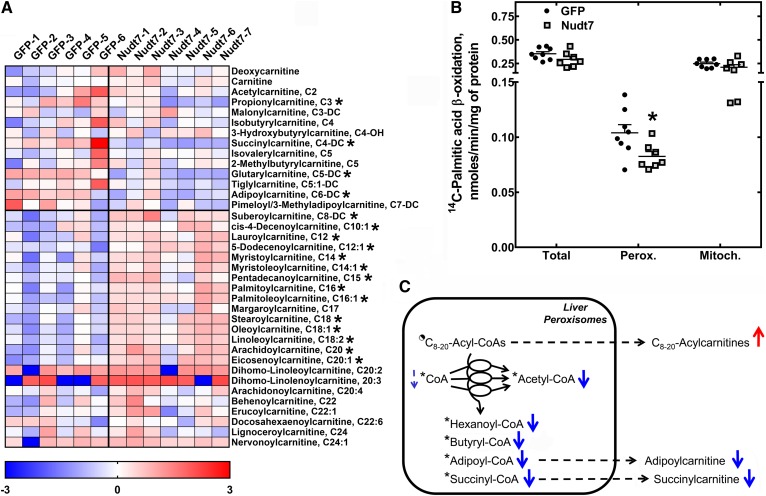Fig. 6.
Nudt7 overexpression in the fasted state decreases the rate of peroxisomal fatty acid oxidation. A: Heat plot of all the short-, medium-, and long-chain acylcarnitines, plus free carnitine and deoxycarnitine, detected by global metabolic profiling. B: Primary hepatocytes were isolated from fasted Nudt7 and GFP mice and incubated with [1-14C]palmitic acid in the presence or absence of etomoxir, as described in the Materials and Methods. Data are reported as the mean (horizontal lines) of measurements on individual mice (circles and squares) ± SEM. *P < 0.05. C: Schematic representation of the oxidation of medium- and long-chain acyl-CoAs (C8–20-acyl-CoAs) to short-chain acyl-CoAs in the peroxisomes. Known substrates of Nudt7 are marked by an asterisk. The half-filled circle indicates that some C8–20-acyl-CoAs (i.e., octanoyl- and lauroyl-CoA) are good substrates of Nudt7, but some others (i.e., stearoyl-CoA) are not. A decrease in the rate of peroxisomal fatty acid oxidation in the Nudt7 livers correlated with a decrease in the concentration of short-chain acyl-CoAs and correspondent acylcarnitines (thick blue arrows), together with the accumulation of C8–20-acylcarnitines. The decrease in free CoA missed statistical significance (P = 0.07), and this is indicated by a thin dashed arrow. Acylcarnitines derived from peroxisomal acyl-CoAs can be formed directly in the peroxisomes or outside the organelles following the release of the acyl groups as free fatty acids. Unlike acyl-CoAs, which are too bulky, the acylcarnitines formed inside the peroxisomes can leave the organelles (71).

